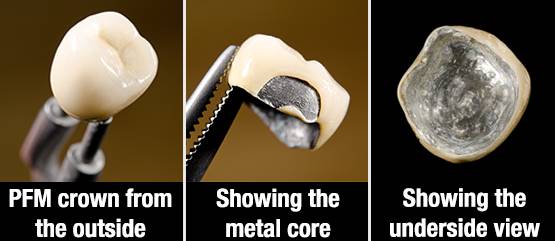
Bruxzir vs PFM : Porcelain-Fused-to-MetalRestorations (PFM)
- PFMs are strong and are suitable for use in all areas of the mouth and in most clinical situations
- Clinical success of Bruxzir vs PFM restorations has been proven through long-term research
- Clinical research has shown that single Bruxzir vs PFM crowns will last for many years, and three-unit PFM bridges also have a relatively long lifespan
- PFM crowns and bridges provide relatively good esthetics, especially during the first few years
- Precision attachments can be used with PFMs, while zirconia restorations have not yet achieved this ability
- PFM restorations can be used for long-span bridges and have proven to be an effective material choice in the longer term.
THE DOWNSIDE
It can be difficult to create highly esthetic restorations because of the metal substructure. The substructure must be masked with opaque and may remain slightly visible even after layering with porcelain. Opaque also prevents light from passing through the restoration as it would with a natural tooth.
Another potential problem with Bruxzir vs PFM restorations is gum recession. Over time, as gum tissue recedes, the metal margin of the Bruxzir vs PFM is exposed, creating a grayish colored line that isn’t esthetically pleasing. One way to overcome this problem is to use a porcelain margin, but this may not always be a practical solution.
Bruxzir vs PFM crowns are layered with feldspathic porcelain, which is a relatively weak material that wears opposing teeth at a very high rate.
The crown’s porcelain portion can also chip or break off. Next to all-ceramic crowns, porcelain-fused-to-metal crowns look most like normal teeth. However, sometimes the metal underlying the crown’s porcelain can show through as a dark line, especially at the gum line and even more so if your gums recede.

Zirconia Restorations: BruxZir
Zirconia offers some significant physical properties that are advantageous for dental restorations besides its high strength. It has a similar color to natural teeth, which reduces the need to opaque it or mask it as would be done for a metal substructure. Zirconia also has good opacity.
Impeccable strength: Zirconia is even stronger than porcelain. In fact, when compared to their porcelain counterparts, zirconia crowns offer 200 percent higher bending strength and flexibility. Optimal comfort: Zirconia crowns do not transmit temperature fluctuations in the same way as traditional restorations.
- The material provides high-strength
- The high biocompatibility of zirconia will not cause allergies in patients who have allergic reactions to PFM restorations
- They have good soft tissue response is useful for patients suffering from soft tissue irritation caused by PFM or metal restorations
- Restorations are precision-fitted, so margins are extremely accurate
- They are ideal for full crown restorations where cosmetics are important and additional strength and durability are required
- They are resistant to hot and cold, which reduces hypersensitivity
- Less tooth preparation is required
- Solid zirconia is suitable for bruxers due to its durability
- They can mask underlying tooth discoloration, implant abutments, and metal cores
- Gum recession will not affect the esthetics, and marginal discoloration will be avoided
The disadvantages of zirconia crowns are minimal. The toughness of the material has raised some concerns about friction against the tooth root and wearing down opposing teeth. Frequent checks, however, help to reduce any possible risks to opposing teeth.

You are informed about the BRUXIR UPGRADE with these benefits: Resistant to chipping because it is made of solid zirconia with no porcelain overlay, Glazed to a smooth surface to reduce plaque accumulation, and much more.
Opting not to upgrade will default to standard materials such as Porcelain Fuse Metals or others which is your personal preference.